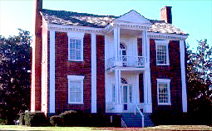Vann House Public History Project
To learn more about the Vann House, check out my book, The House on Diamond Hill: A Cherokee Plantation Story.
Download: African American History at the Chief Vann House
Since 2002 I have been actively engaged in a public history project focused on the Chief Vann House State Historic Site. The Chief Vann House, operated by the Georgia Department of Natural Resources, offers a rare opportunity for the exploration of African American life among American Indians. James Vann was a wealthy Cherokee who built a plantation called Diamond Hill in present-day north Georgia. Vann and his family possessed over 100 of the 583 black slaves owned by Cherokees in the first decade of the nineteenth century. The Vann home has been restored and is open to the public for guided tours and events.

I first visited this site in 1998 while doing research for my book on the Shoeboots family. I was dismayed to discover that the tour of the Vann House made no mention of the history of African American slavery in the Cherokee Nation or of the human stories of the many black men, women, and children who had lived and worked on the grounds. I felt concerned that the slogan of the house museum: “The Showplace of the Cherokee Nation,” was romanticizing and even glorifying a place where the abuse of human beings had been common. And so I became committed to a more ethical interpretation of the historical significance of this site and to bringing a multifaceted picture of the Vann House history into public view. Toward this end, I entered into a sensitive, long-term dialogue with the committed park rangers who operate the site about the absence of African American history and about potential projects that might address this gap.
The most exciting component of my public history work with the Vann House museum is a research project that I developed with students in an upper level undergraduate course at the University of Michigan, titled “Blacks, Indians, and the Making of America.” With the goal of increasing awareness of African American history at this historic site, nearly thirty students in the class from diverse racial and cultural backgrounds researched the history of the Vann plantation, relying on sources ranging from Moravian missionary diaries to Works Progress Administration narratives of former slaves of Indians, to classic secondary sources on slavery in the Cherokee Nation. The students shared their research findings with their classmates and then wrote individual papers on their chosen topics. The papers were edited, shortened, combined, and compiled over a summer by a team of African American and Native American students who worked closely with me. The result of this work is a booklet titled African American History at the Chief Vann House, intended to illuminate, commemorate, and contextualize the lives of enslaved Africans and African Americans who labored on the Vann plantation. The booklet is available at the Vann House and in PDF form on this page.
6 Comments
Jeno Vann
Looking to find my ancestors of African American decent who were possibly slaves on this plantation.
Jacqueline Worthington
I am African American and a Vann from Northeastern NC. Through DNA I am matching with John Trader Vann and Chief Vann. This discovery has intrigued me. I would love to connect with you.
Mattison B
I too am a resident of northeastern NC, and was just curious about where specifically you are from?
Tresa
Thanks for your comment, Mattison. Do you have ancestors connected to Vann plantation?
Marquette Hawkins
Through a DNA match I am a descendant of Chief Joseph Vann via my maternal lineage.
Durwood Snead
Tiya,
I am a long time resident of Forsyth County, GA (35 years). I am intrigued with the Vann family history and have visited Diamond Hill, James Vann’s gravesite, the two taverns and read as much as I can find on the Vann family. James Vann operated in Forsyth County and was killed here and buried here. With our dark racial history, especially around the events of 1912, I and several others started a college scholarship for Black descendants of those expelled from the county in 1912. We are in our third year. (www.forsythscholarship.org)
I would love to learn more about the Vanns and slavery and any resources you could direct me too would be appreciated.
Thanks
Durwood Snead